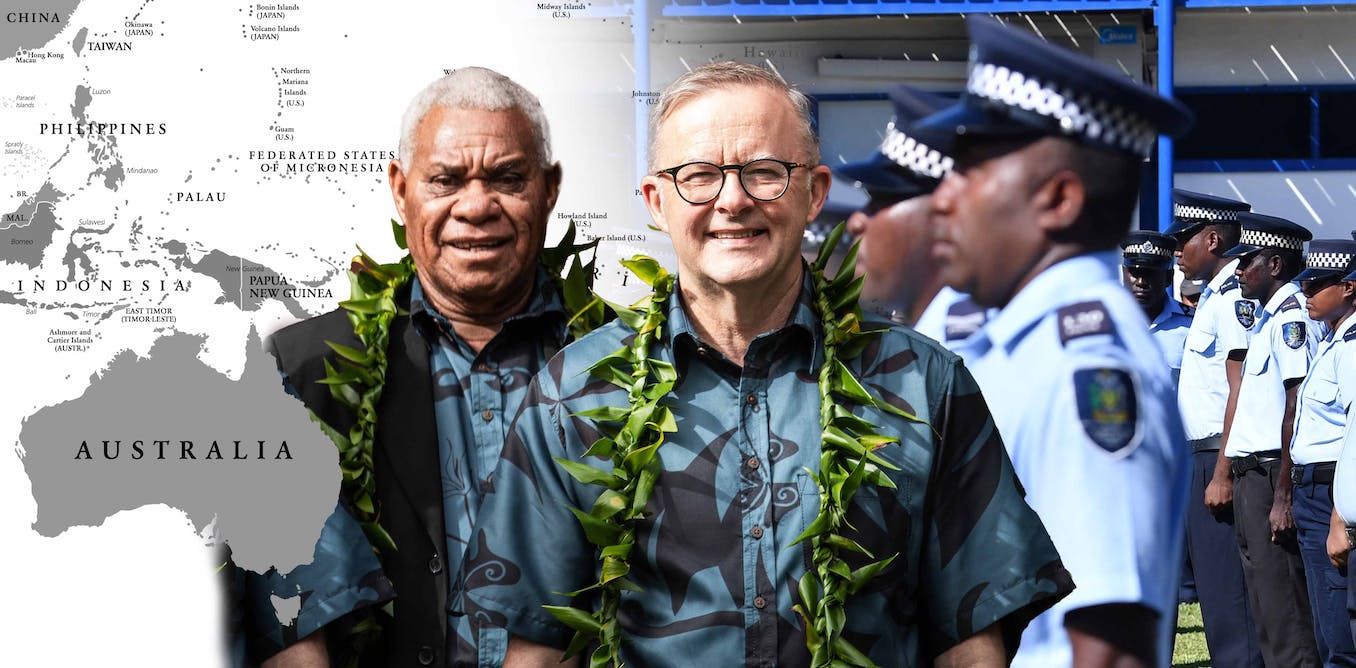After years of neglect, there’s a reason why Pacific leaders now describe the Pacific Islands’ geopolitical landscape as “crowded and complex”. Many democratic powers have recently refocused their attention on the region, including Australia, the United States, New Zealand, France, the United Kingdom and Japan.
One after another, they are rolling out big-ticket initiatives to improve their reputations and relationships in the region. While some of these projects make good developmental sense – for instance, Australia’s A$4 billion infrastructure financing agency for the region (although questions are being asked about debt sustainability, given how quickly it has ramped up) – the rationale for others is less clear.
But what all these initiatives have in common is that they are being formulated with a sense of urgency – as a reaction to Chinese offers of assistance.
As the Pacific Islands Forum is holding its annual summit this week, we’ve asked experts on the Pacific to examine the great power competition in the region. How are countries like the US, Australia, China and others attempting to wield power and influence in the Pacific? And how effective has it been? This is the first story in a four-piece series.
There’s a risk to all this urgent energy: it’s difficult to know who is doing what, and where. To help meet this challenge, our Statecraftiness mapping project shows how all of these outside powers are seeking to engage with and influence the region.
Our StoryMap shows that the US, Australia and their partners do a lot in the region. Given the depth of this engagement, they should now shift their priorities from reacting to every Chinese announcement towards a more considered approach. This could better anticipate and respond to their interests and those of Pacific Island countries.
There are signs they are beginning to do this: the Partners in the Blue Pacific initiative announced in 2022 by the US, Australia and other partners may help to improve the coordination of their assistance.
Based on our analysis, we make five recommendations about how these partners could further implement proactive “statecraft” in the region.
1. Understand that all influence is relative
In 2018, a rumour of a potential Chinese military base in Vanuatu triggered a wave of concern in Western capitals. Four years later, news of a security agreement between China and Solomon Islands amplified these anxieties.
Scroll down the images to show military installation locations.
But despite all the discussion about a potential Chinese military presence in the region, what is often overlooked is the existing presence of Australian, American and French forces (although such militarisation is contested by many islanders).
Similarly, there are concerns the China-Solomon Islands agreement could pave the way for a Chinese police presence in the region. This, too, led to reactive policymaking. After China provided police training in the Solomon Islands, Australia countered by donating rifles and police vehicles, and then China donated water cannons, motorbikes and vehicles.
Scroll down the map to reveal policing assistance in the region.
But our StoryMap shows that China’s rather nascent policing activities are nowhere near as broad-reaching as the assistance provided by Australia and New Zealand.
2. Acknowledge the difference between quantity and quality
As our StoryMap below shows, Australia is the only partner state with diplomatic posts in all Pacific island countries, followed closely by New Zealand. The US, Japan, France, Taiwan, India and Indonesia also have a diplomatic presence, and others are looking to open embassies.
Scroll down the timeline to show diplomatic posts in the region.
But the number of diplomatic posts does not necessarily equate to quality or effectiveness. This is because individuals, not policies, are the most important determinants of whether a country’s “statecraft” efforts succeed.
And diplomatic presence is not always reciprocated. Niue, Tuvalu, Micronesia, Cook Islands, Palau and Kiribati do not have diplomatic missions in Australia. Instead, they have missions in cities where international institutions are, such as New York and Geneva. This reflects how Pacific countries prioritise where they place their limited number of diplomats.
Scroll down the timeline to show diplomatic visits.
High-level visits to the Pacific by foreign leaders and officials have also increased dramatically in the past 18 months. Australian Prime Minister Anthony Albanese, US Secretary of State Antony Blinken, French President Emmanuel Macron, Chinese Foreign Minister Wang Yi, British Foreign Minister James Cleverly and Indian Prime Minister Narendra Modi have all made appearances.
But, again, the quantity of diplomatic engagement does not necessarily lead to quality relationships, which are “the enduring currency of influence” in the Pacific.
Social media, for instance, has greater reach and can impact countries’ diplomatic negotiations and shape their influence outside formal meetings.
To try to understand the effectiveness of social media as a diplomatic tool, we analysed social media followings of diplomatic missions in the region. As expected, countries with close relationships tended to have high numbers of followers.
However, social media engagement does not necessarily indicate that people agree with – or even think favourably of – a country. For example, the large following of the US embassy in Papua New Guinea could be due to recent controversies involving the mission there.
Some diplomatic missions also pay for extended social media reach through boosted posts. We also found examples of automated bots commenting on posts.
3. Focus on long-term, rather than short-term, engagement
The value of long-term engagement was illustrated in the US response to the Solomon Islands-China security agreement.
Senior US officials immediately flew to Honiara, without having had a diplomatic presence there for 29 years. Sudden, overtly self-serving engagement is seldom effective.
Soft power comes in many forms, such as media broadcasts, scholarships, church networks, sports tournaments, language training and cultural exchanges. Many of these are often overlooked by analysts, who tend to focus on more quantifiable tools of “statecraft”, such as aid, loans, infrastructure projects and security assistance.
Scroll down and click on scholarship initiatives to show locations.
But this misses the long-term value of soft power initiatives. These have the potential to shape the beliefs, attitudes and opinions of communities in ways that are harder to immediately identify, but often more influential.
4. Distinguish between announcement and implementation
In 2020, news broke that China had agreed to a A$204 million deal with Papua New Guinea to establish a fishery industrial park project on Daru Island.
Concerned the facility would give China a foothold only a few kilometres from its shores, Australia quickly signed a A$30 million agreement with PNG for an “economic empowerment program” on Daru.
Since 2020, there has been no substantive progress on the Chinese project. But it’s unlikely Australia’s reaction influenced this. While the pandemic may have delayed things, the more plausible explanation is that the project was an “outlandishly ambitious” “mirage” that will “never eventuate”.
Any development initiative on Daru Island — long a neglected region — is welcome. But the speed of Australia’s reaction exemplified how the significance of such an announcement can be misinterpreted.
5. Make sure the right country gets the credit
The US, Australia and its partners frequently subcontract the delivery of their programs in the Pacific to nongovernmental organisations and private contractors. Even Australian policing and justice assistance is increasingly coordinated by private contractors.
But as some Pacific islanders have told us, with so much American and Australian assistance provided by other organisations, it’s often unclear where it comes from.
And sometimes credit goes to the wrong party. Many infrastructure projects are funded by institutions such as the Asian Development Bank. Though much of the bank’s funding comes from Australia (A$11.31 billion) and the US (US$26.9 billion), the projects themselves are often built by Chinese state-owned enterprises.
So, China receives the credit – and the reputational and relationship boosts that come with it.
More proactive statecraft can help in this regard. But whether these influence attempts succeed will be determined by Pacific countries themselves. And these countries aren’t passive: they are attempting to influence their partners in return.



 Hallucinogens approved for treating psychiatric disorders: what does the science say?
Hallucinogens approved for treating psychiatric disorders: what does the science say?  Hedera's Whale Watch: Price Soars as New CEO Sets Bold Vision for 2025
Hedera's Whale Watch: Price Soars as New CEO Sets Bold Vision for 2025  Holiday Pause: Gold Prices Remain Steady Amid Economic Shifts
Holiday Pause: Gold Prices Remain Steady Amid Economic Shifts  Solana's $300 Target: Growing ETF Interest and Stablecoin Surge Fuel Optimism
Solana's $300 Target: Growing ETF Interest and Stablecoin Surge Fuel Optimism  Gold's Resilience: A Safe Haven Amidst Geopolitical Tensions
Gold's Resilience: A Safe Haven Amidst Geopolitical Tensions  Dogs and cats get diabetes too. Here’s what to look out for and how to manage it
Dogs and cats get diabetes too. Here’s what to look out for and how to manage it  Gold's Resilience Tested: Tariff Fears and Economic Signals Shape Market Strategy
Gold's Resilience Tested: Tariff Fears and Economic Signals Shape Market Strategy  Crude Oil Prices Surge Amid U.S. Inventory Declines: What’s Next?
Crude Oil Prices Surge Amid U.S. Inventory Declines: What’s Next?  Sonic Labs' Bold Leap: Fantom's Transformation into a Scalable Blockchain Giant
Sonic Labs' Bold Leap: Fantom's Transformation into a Scalable Blockchain Giant  5 elections to watch in 2025
5 elections to watch in 2025  Sport produces mountains of high-tech waste. We are finding new ways to recycle it
Sport produces mountains of high-tech waste. We are finding new ways to recycle it  Like your pet more than people? So did some of the Greco-Romans
Like your pet more than people? So did some of the Greco-Romans 


































